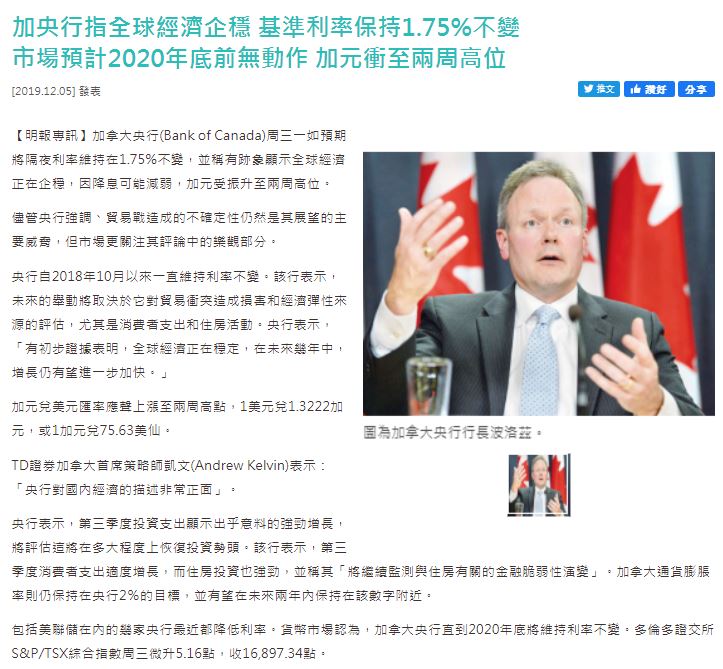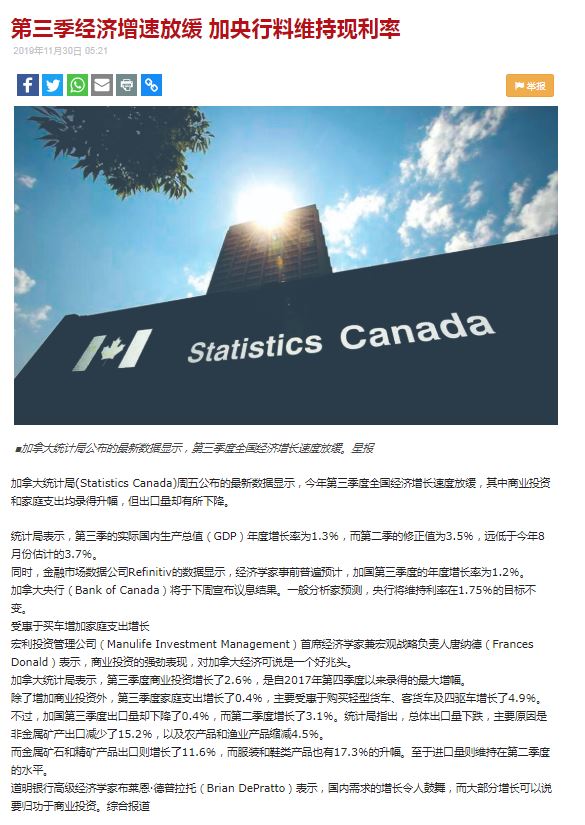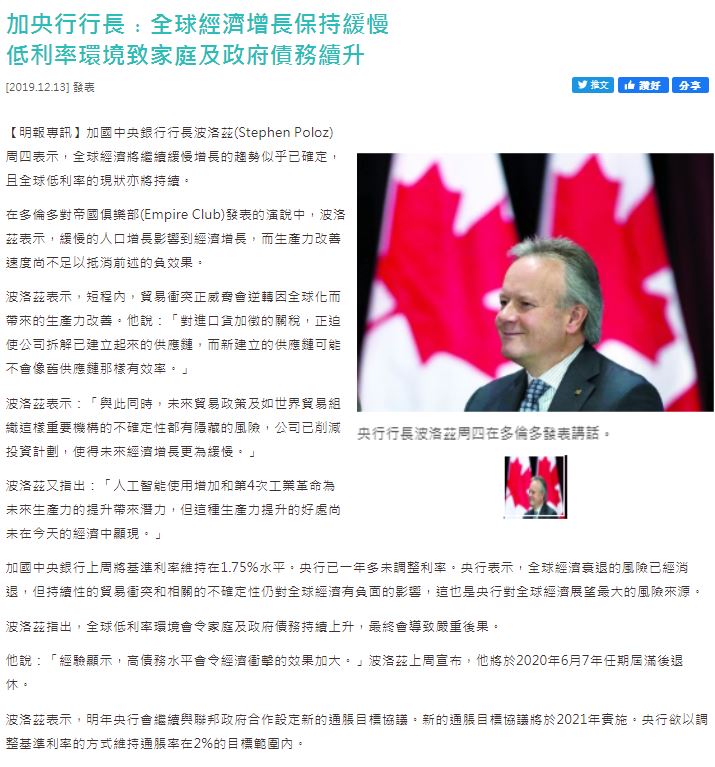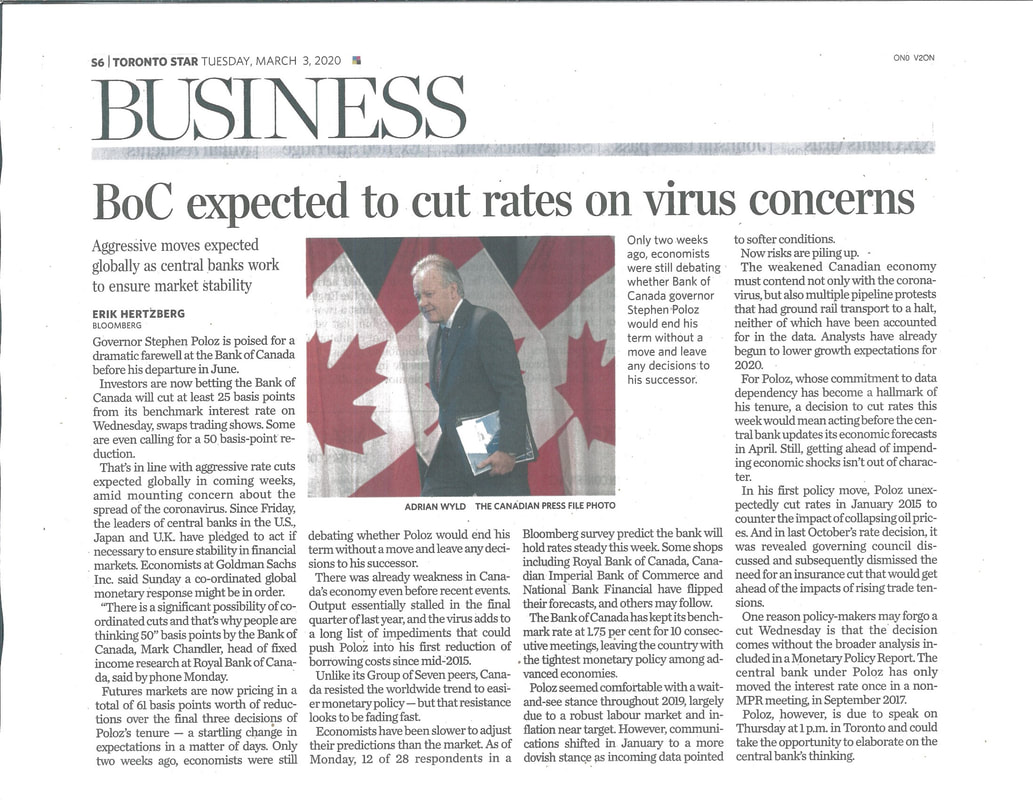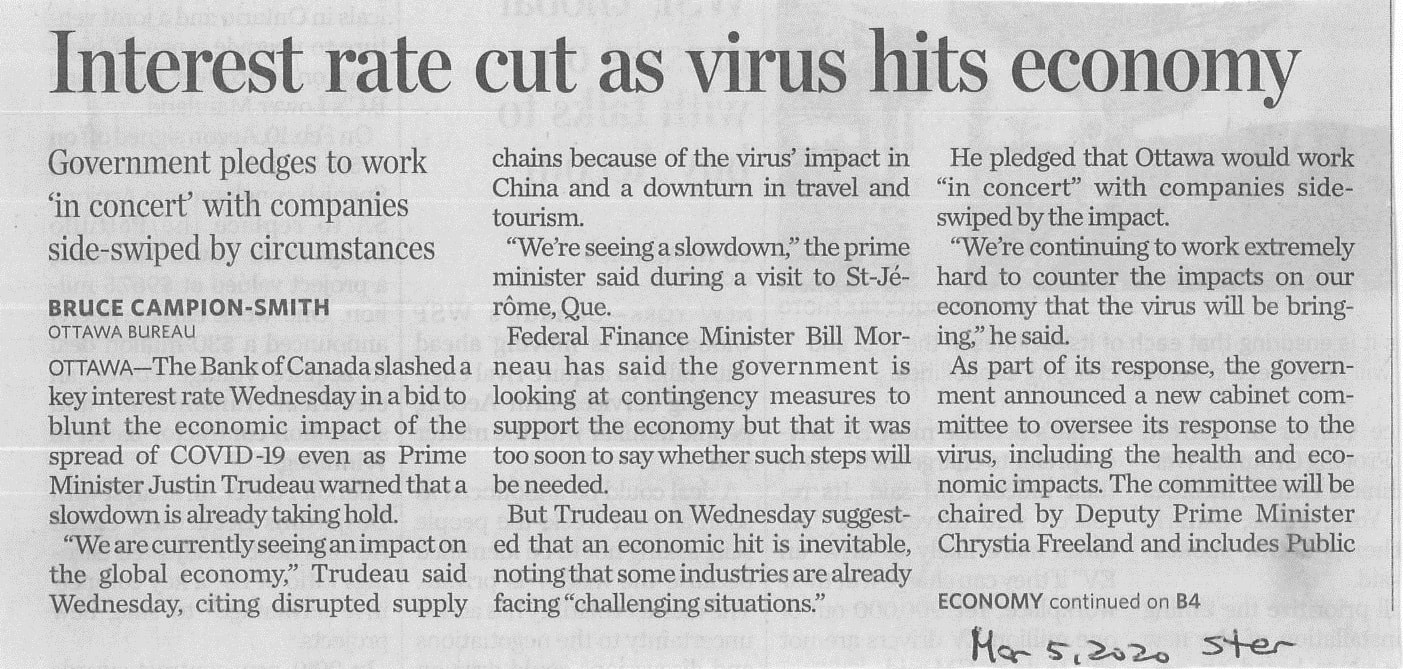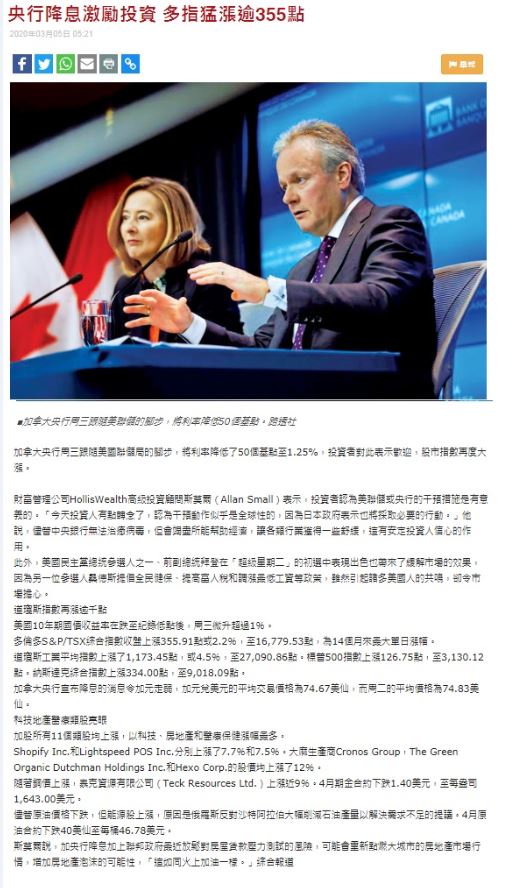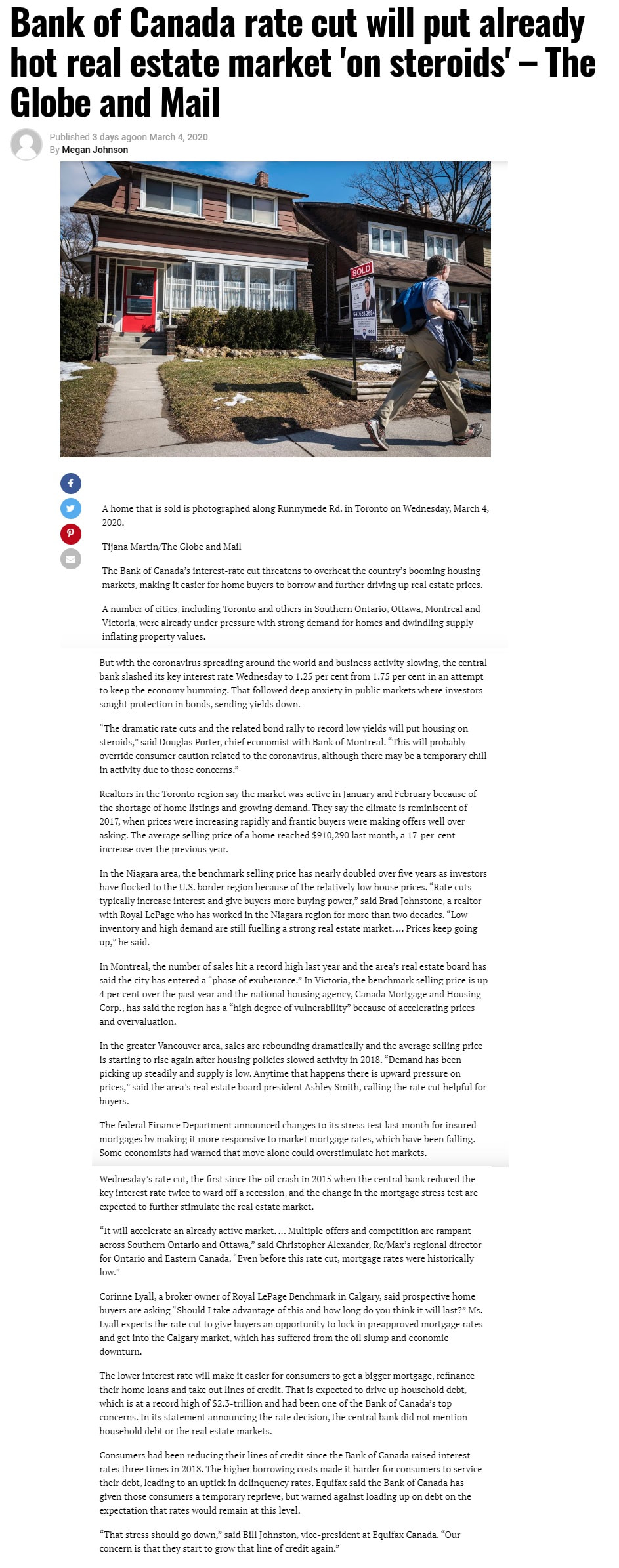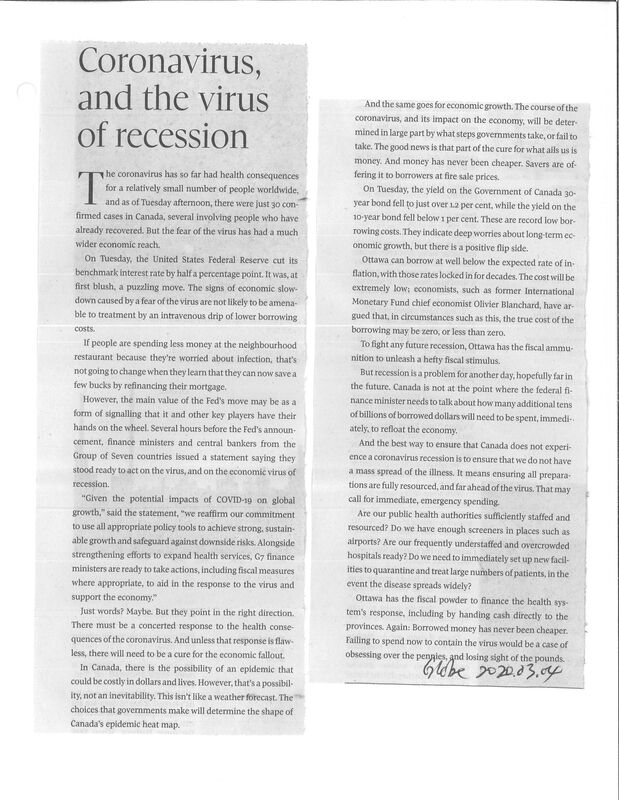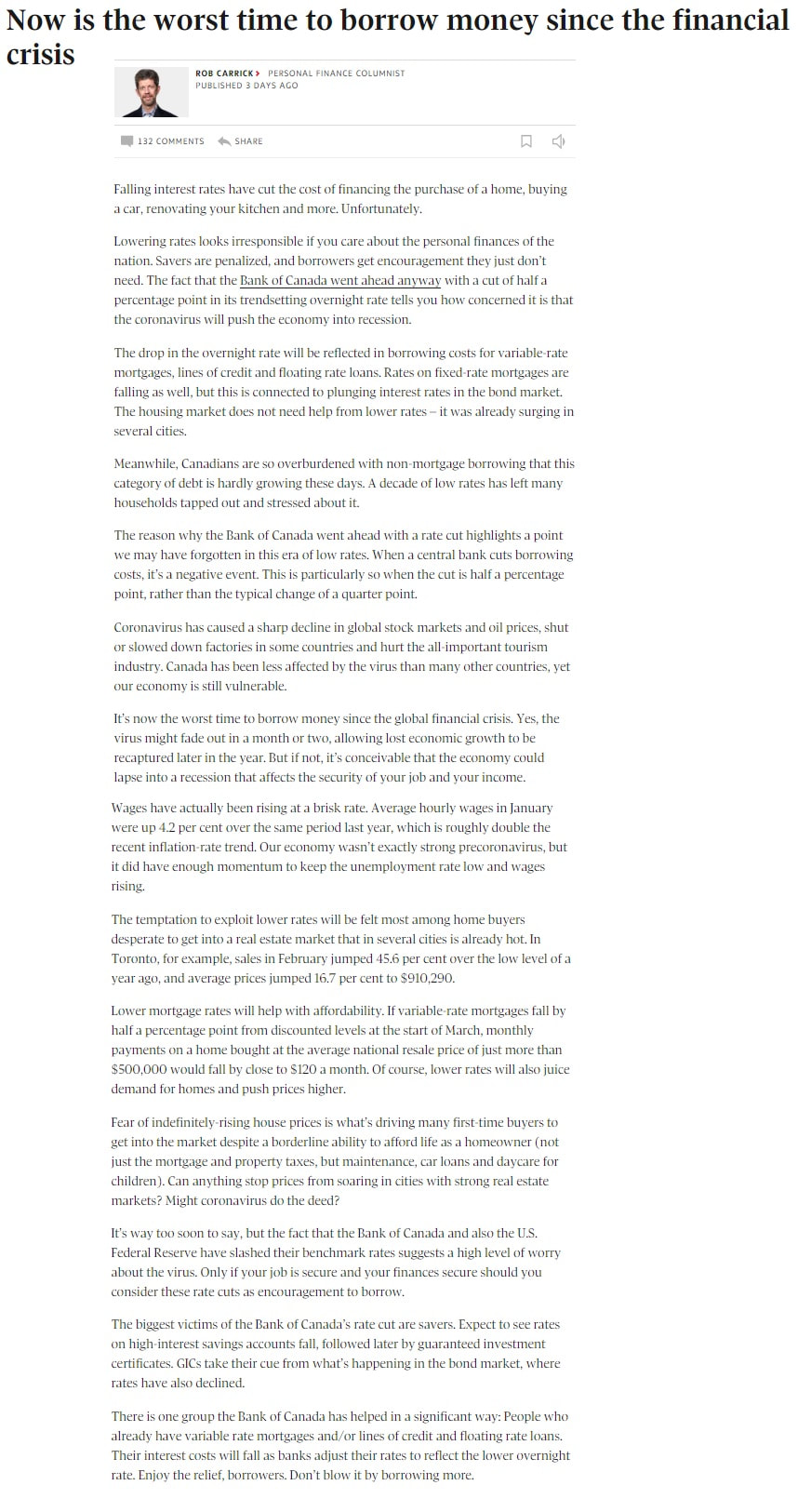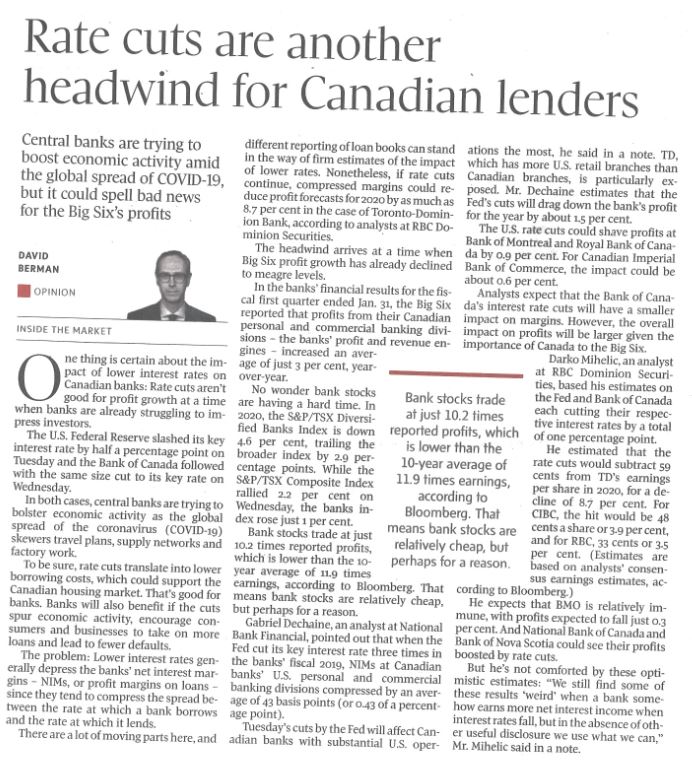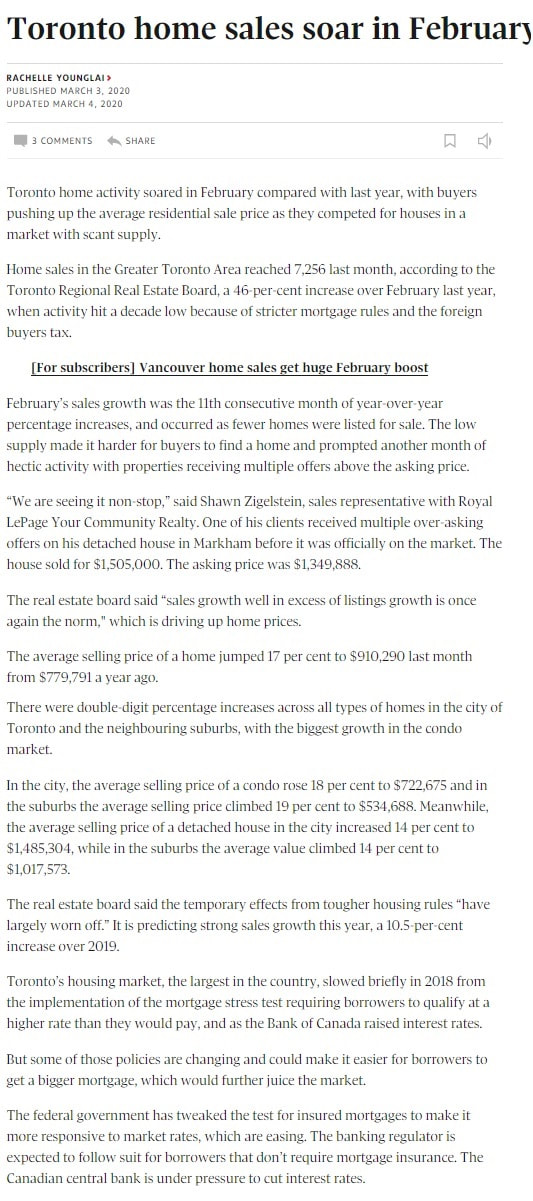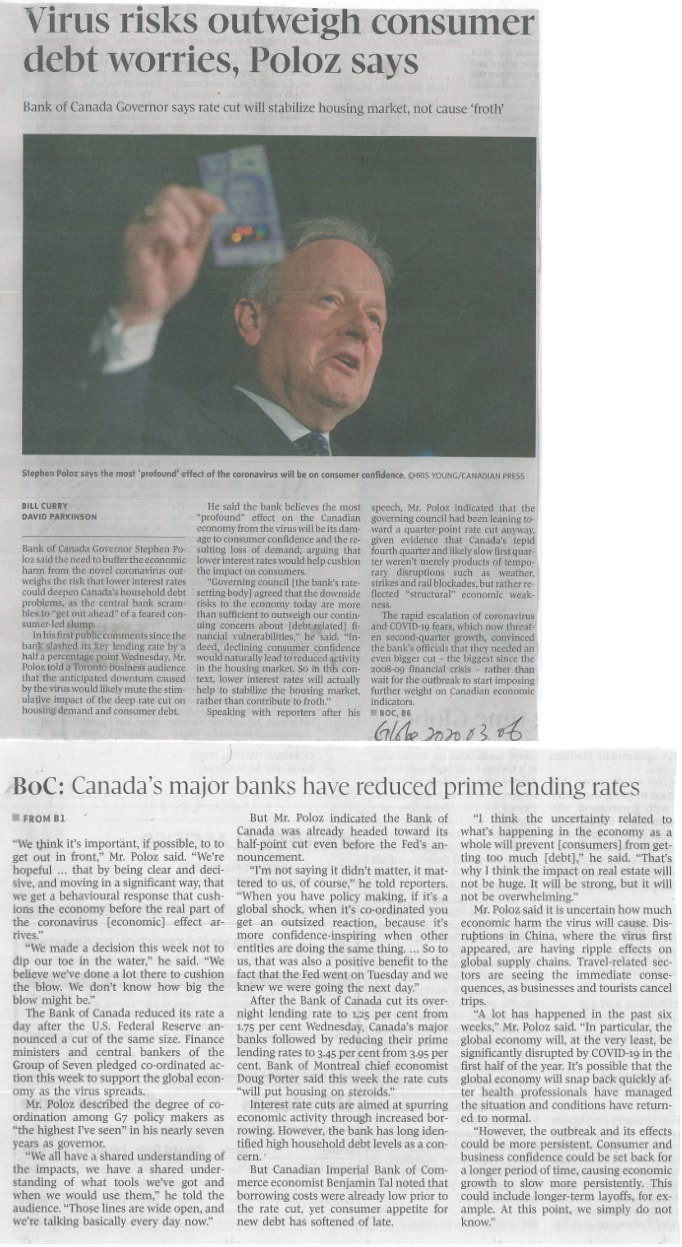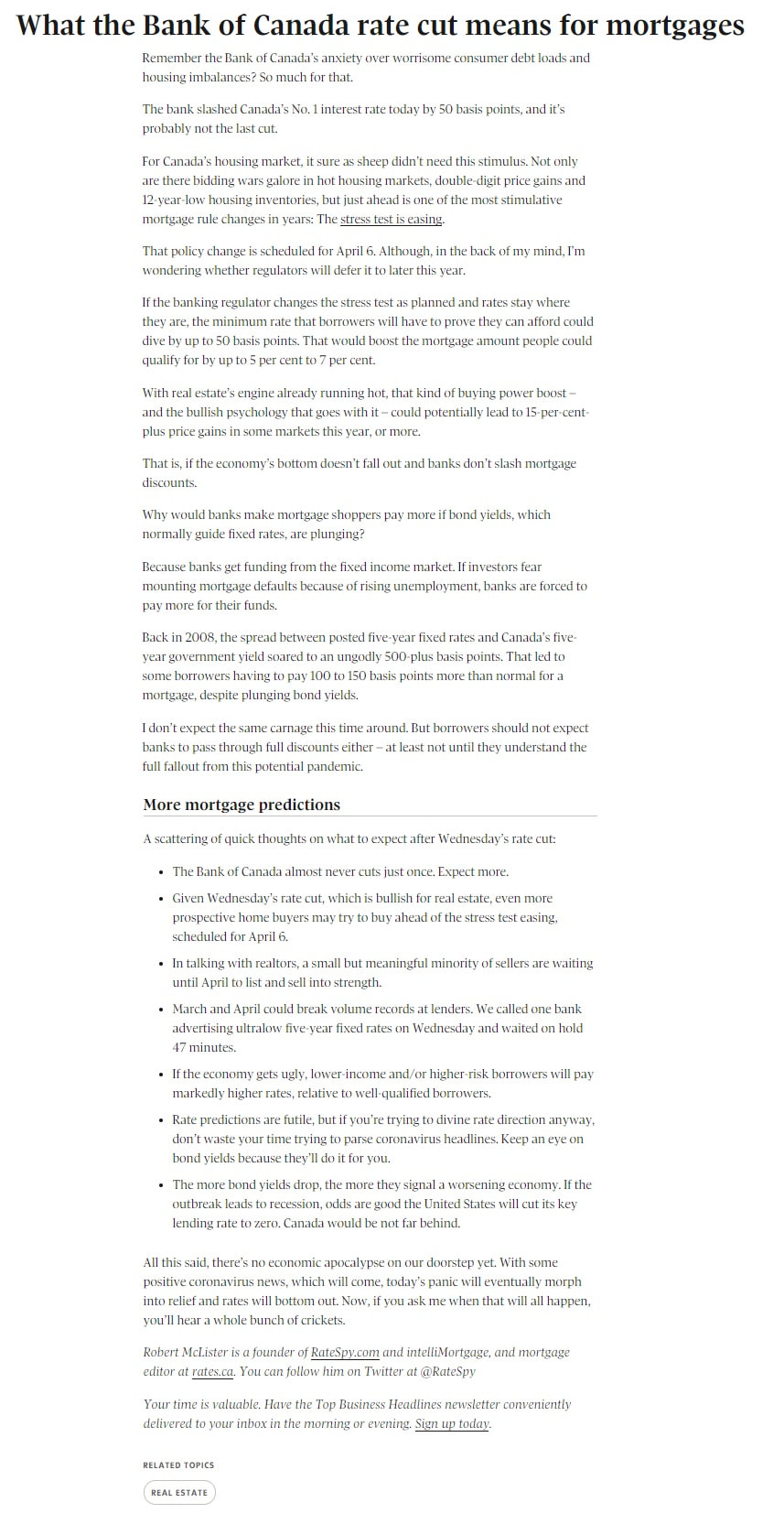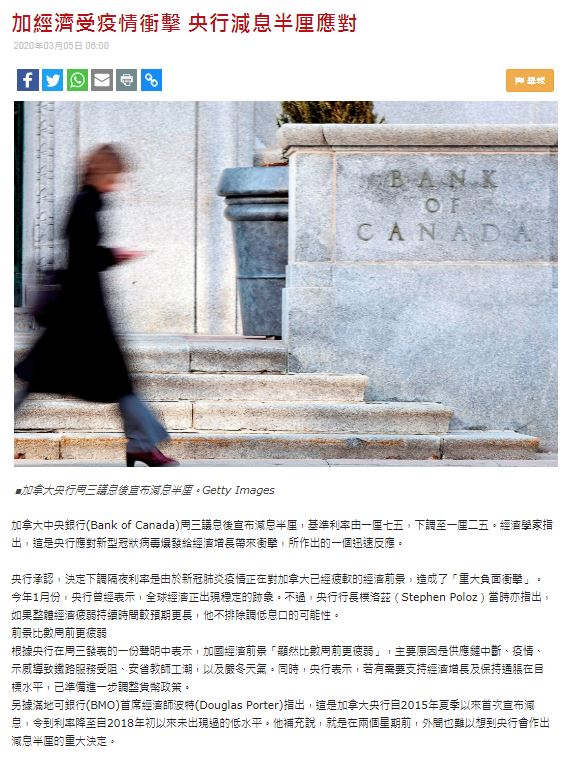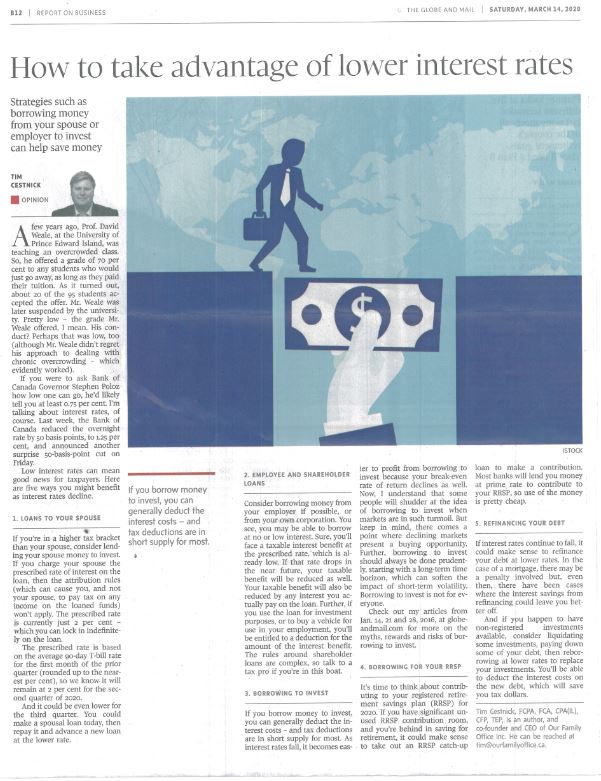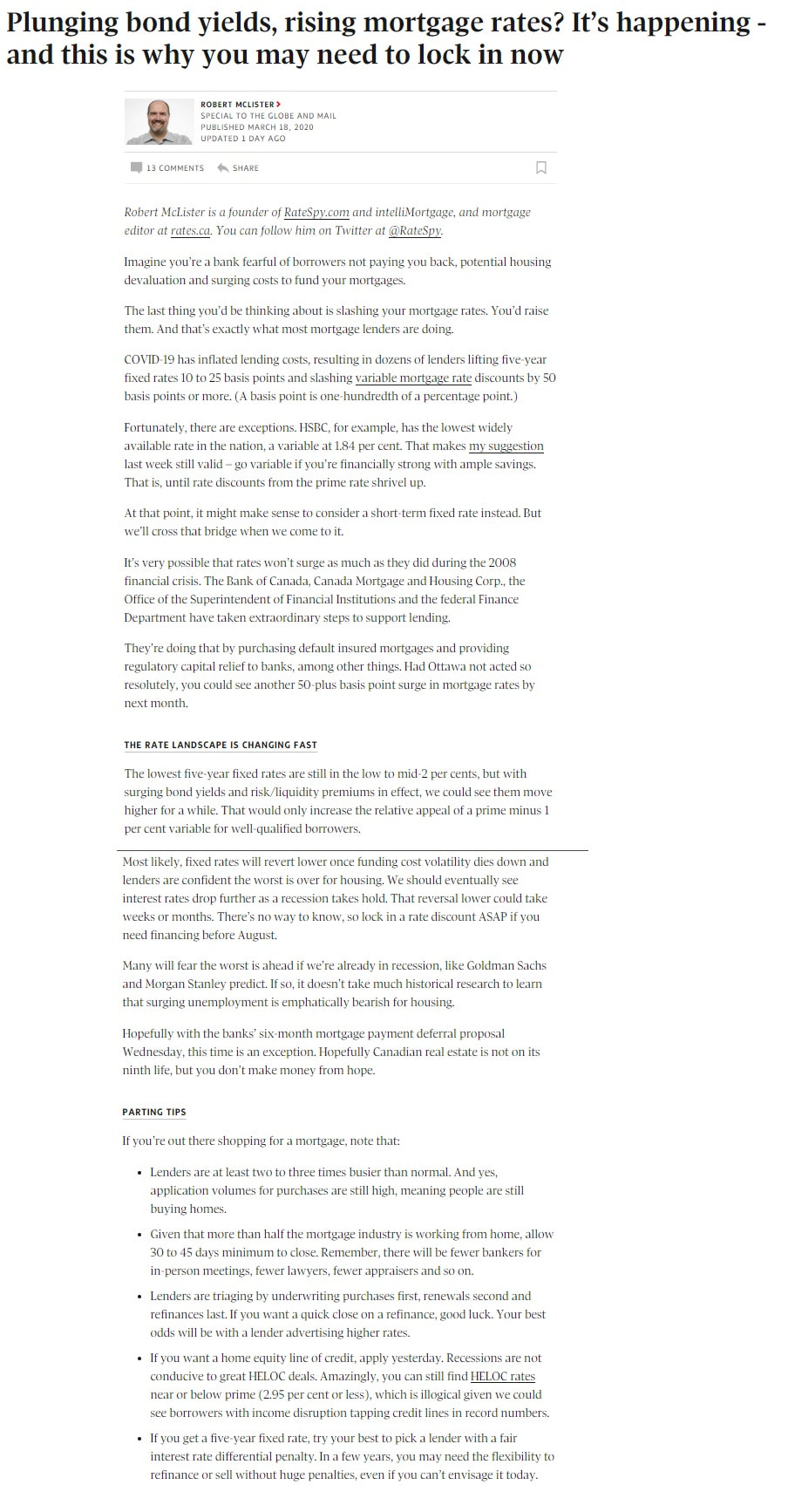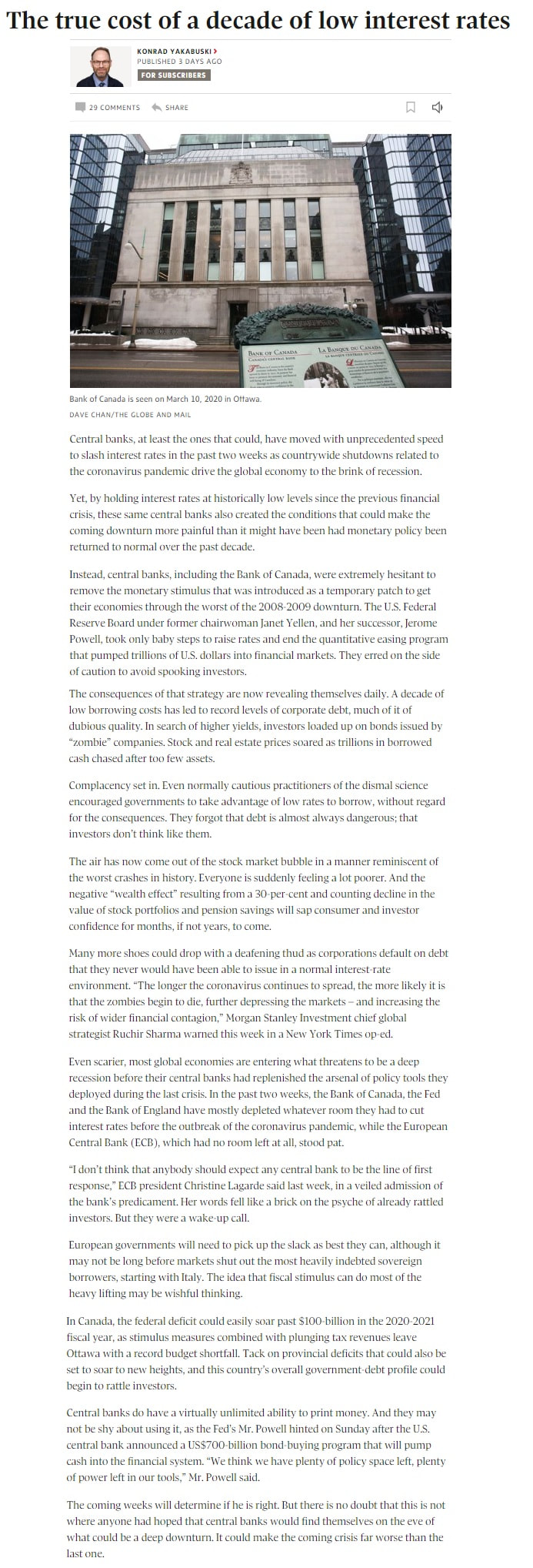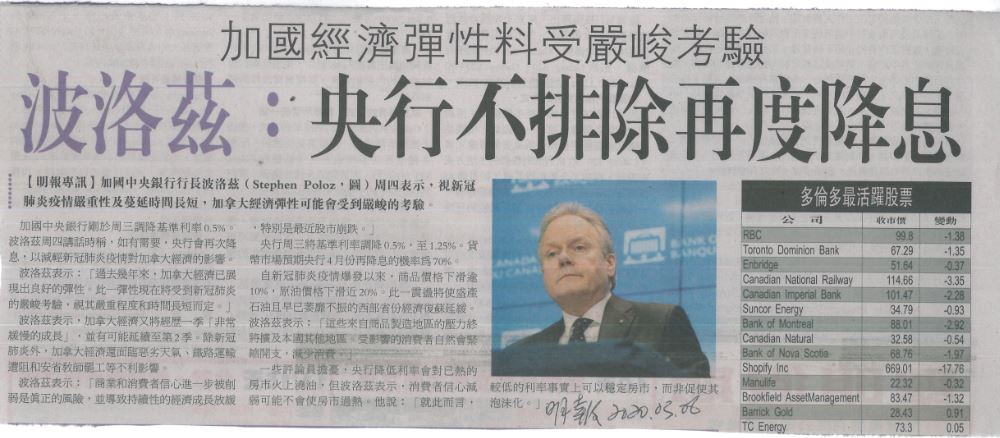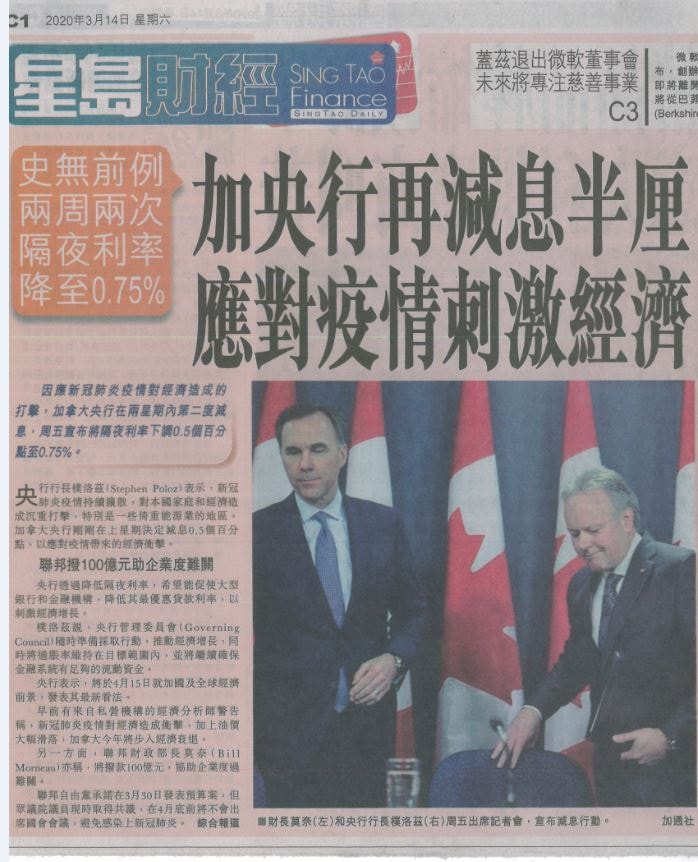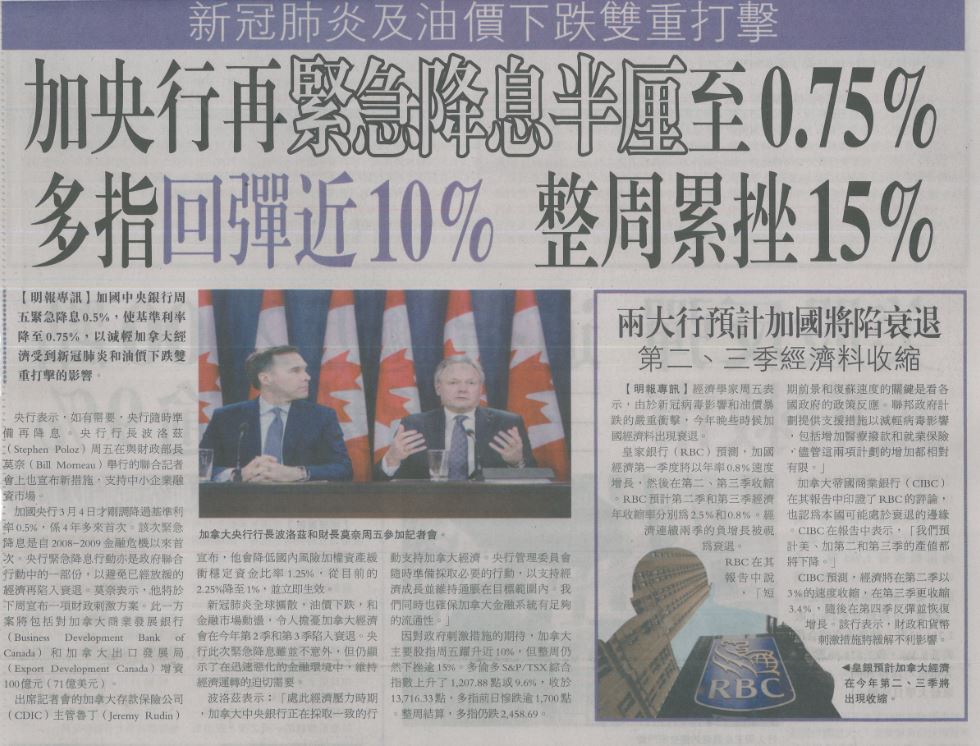INTEREST RATE
Bank of Canada holds interest rate, warns economy's resilience to be 'tested'(2019.10.31)
OTTAWA -- The Bank of Canada kept its key interest rate on hold Wednesday to position the country as an exception among advanced economies that have already started responding to a fading global economy.
Governor Stephen Poloz's team says the domestic economy has held up well in many respects and inflation has been close to target.
They warn, however, that Canada isn't immune to the negative effects of slowing global growth.
"Governing council is mindful that the resilience of Canada's economy will be increasingly tested as trade conflicts and uncertainty persist," the central bank said in a statement.
"In considering the appropriate path for monetary policy, the bank will be monitoring the extent to which the global slowdown spreads beyond manufacturing and investment."
The Bank of Canada's decision to hold steady makes it stand out among its international peers. It acknowledged Wednesday that dozens of policy-makers around the globe have taken steps to cushion the blow from the weakening world economy.
Since the release of its last quarterly update in July, the bank said more than 35 central banks in advanced and emerging economies have eased monetary policy to address fading growth and soft inflation pictures in their countries.
"A growing number of countries have responded with monetary and other policy measures to support their economies," the bank said.
The U.S. Federal Reserve is widely expected to cut its borrowing rate Wednesday for a third-straight meeting, a move experts say would leave Canada with the highest rate in the industrialized world. It's a very rare occurrence for the Bank of Canada and the Fed to make rate announcements on the same day.
The Bank of Canada's status as an outlier will likely increase the pressure on Poloz to adjust his own policy rate in the coming months.
To guide its future decisions, the central bank said it will monitor any changes to Canada's sources of strength, especially consumer spending and housing markets.
It also plans to watch for the roll out of expected fiscal support from the federal government and its timing. The recent election campaign featured promises of multibillion-dollar income tax cuts, which could help lift the economy.
Fiscal support would also provide breathing room for the central bank. Any move to lower borrowing rates would risk fuelling Canada's already near-record levels of household debt.
The decision to hold the rate at 1.75 per cent was widely expected by markets, and it left the benchmark at the same level it's been for just over a year.
Since the summer, the bank said the global outlook has continued to deteriorate, which has held back business investment, growth and trade. The U.S.-China trade war, and its worldwide fallout, has been the key factor behind the slowdown.
In a separate report Wednesday, the bank predicted global growth in 2019 will dip to its lowest level since the financial crisis.
It also released updated domestic projections Wednesday to reflect developments since its last forecast in July.
Following Canada's unexpectedly strong second-quarter growth at an annual rate of 3.7 per cent, the bank predicts expansion at an annual pace of just 1.3 per cent in each of the final two quarters of 2019.
For all of 2019, the bank is projecting growth of 1.5 per cent, up from its 1.3 per cent prediction in July. The bank also forecasts an expansion of 1.7 per cent in 2020, down from its earlier projection of 1.9 per cent, and growth of 1.8 per cent in 2021, down from its previous call of two per cent.
The bank notes the domestic economy has been resilient in many areas -- employment has remained strong, wages have advanced in some regions and housing activity has expanded in most markets. Over the projection horizon, the bank predicts inflation stay close to its ideal target of two per cent, except for an anticipated temporary dip in 2020 due to waning effects of an earlier jump in energy prices.(CTV NEWS)
Governor Stephen Poloz's team says the domestic economy has held up well in many respects and inflation has been close to target.
They warn, however, that Canada isn't immune to the negative effects of slowing global growth.
"Governing council is mindful that the resilience of Canada's economy will be increasingly tested as trade conflicts and uncertainty persist," the central bank said in a statement.
"In considering the appropriate path for monetary policy, the bank will be monitoring the extent to which the global slowdown spreads beyond manufacturing and investment."
The Bank of Canada's decision to hold steady makes it stand out among its international peers. It acknowledged Wednesday that dozens of policy-makers around the globe have taken steps to cushion the blow from the weakening world economy.
Since the release of its last quarterly update in July, the bank said more than 35 central banks in advanced and emerging economies have eased monetary policy to address fading growth and soft inflation pictures in their countries.
"A growing number of countries have responded with monetary and other policy measures to support their economies," the bank said.
The U.S. Federal Reserve is widely expected to cut its borrowing rate Wednesday for a third-straight meeting, a move experts say would leave Canada with the highest rate in the industrialized world. It's a very rare occurrence for the Bank of Canada and the Fed to make rate announcements on the same day.
The Bank of Canada's status as an outlier will likely increase the pressure on Poloz to adjust his own policy rate in the coming months.
To guide its future decisions, the central bank said it will monitor any changes to Canada's sources of strength, especially consumer spending and housing markets.
It also plans to watch for the roll out of expected fiscal support from the federal government and its timing. The recent election campaign featured promises of multibillion-dollar income tax cuts, which could help lift the economy.
Fiscal support would also provide breathing room for the central bank. Any move to lower borrowing rates would risk fuelling Canada's already near-record levels of household debt.
The decision to hold the rate at 1.75 per cent was widely expected by markets, and it left the benchmark at the same level it's been for just over a year.
Since the summer, the bank said the global outlook has continued to deteriorate, which has held back business investment, growth and trade. The U.S.-China trade war, and its worldwide fallout, has been the key factor behind the slowdown.
In a separate report Wednesday, the bank predicted global growth in 2019 will dip to its lowest level since the financial crisis.
It also released updated domestic projections Wednesday to reflect developments since its last forecast in July.
Following Canada's unexpectedly strong second-quarter growth at an annual rate of 3.7 per cent, the bank predicts expansion at an annual pace of just 1.3 per cent in each of the final two quarters of 2019.
For all of 2019, the bank is projecting growth of 1.5 per cent, up from its 1.3 per cent prediction in July. The bank also forecasts an expansion of 1.7 per cent in 2020, down from its earlier projection of 1.9 per cent, and growth of 1.8 per cent in 2021, down from its previous call of two per cent.
The bank notes the domestic economy has been resilient in many areas -- employment has remained strong, wages have advanced in some regions and housing activity has expanded in most markets. Over the projection horizon, the bank predicts inflation stay close to its ideal target of two per cent, except for an anticipated temporary dip in 2020 due to waning effects of an earlier jump in energy prices.(CTV NEWS)
US Fed cuts rates but signals pause in easing cycle(2019.10.31)
WASHINGTON : The Federal Reserve on Wednesday cut interest rates for the third time this year in a move to ensure the US economy weathers a global trade war without slipping into a recession, but signaled its rate-cut cycle might be at a pause.
In lowering its policy rate by a quarter of a percentage point to a target range of between 1.50% and 1.75%, the U.S. central bank dropped a previous reference in its policy statement that it "will act as appropriate" to sustain the economic expansion - language that was considered a sign for future rate cuts.
Instead, the Fed said it will "monitor the implications of incoming information for the economic outlook as it assesses the appropriate path" of its target interest rate, a less decisive phrase.
Fed Chair Jerome Powell will hold a news conference at 2:30 p.m. EDT (1830 GMT) to elaborate on the decision.
Kansas City Fed President Esther George and Boston Fed President Eric Rosengren dissented from the decision. They have opposed all three Fed rate cuts this year as unnecessary.
The Fed's description of the U.S. economy on Wednesday remained largely unchanged, with labor markets said to be "strong," and economic activity "rising at a moderate rate."
As in its previous policy statement, the Fed said it took the action to reduce borrowing costs "in light of the implications of global developments for the economic outlook as well as muted inflation pressures."
The Fed said business investment and exports remained "weak."
The central bank and U.S. economy are at an unusual juncture.
Unemployment is near a 50-year low, inflation is moderate, and data earlier on Wednesday showed gross domestic product grew at an annual rate of 1.9% in the third quarter, a slowdown from the first half of the year but not as sharp a decline as many economists expected and some Fed officials feared.
But parts of the economy, particularly manufacturing, have stuttered in recent months as the global economy slowed. Businesses have pared investment in response to the U.S.-China trade war that both raised tariffs on many goods, and also made the world a riskier place to make long-term commitments.
While that has not had an obvious impact yet on U.S. hiring or consumer spending, Fed officials felt a round of "insurance" rate cuts was appropriate to guard against a worse outcome. The Fed cut rates in July and again in September, and by doing so hoped to encourage businesses and consumers with more affordable borrowing costs.
The approach was successful in the 1990s when risks developed during another prolonged period of economic growth.(Globe and Mail, Lindsay Dunsmuir & Howard Schneider)
In lowering its policy rate by a quarter of a percentage point to a target range of between 1.50% and 1.75%, the U.S. central bank dropped a previous reference in its policy statement that it "will act as appropriate" to sustain the economic expansion - language that was considered a sign for future rate cuts.
Instead, the Fed said it will "monitor the implications of incoming information for the economic outlook as it assesses the appropriate path" of its target interest rate, a less decisive phrase.
Fed Chair Jerome Powell will hold a news conference at 2:30 p.m. EDT (1830 GMT) to elaborate on the decision.
Kansas City Fed President Esther George and Boston Fed President Eric Rosengren dissented from the decision. They have opposed all three Fed rate cuts this year as unnecessary.
The Fed's description of the U.S. economy on Wednesday remained largely unchanged, with labor markets said to be "strong," and economic activity "rising at a moderate rate."
As in its previous policy statement, the Fed said it took the action to reduce borrowing costs "in light of the implications of global developments for the economic outlook as well as muted inflation pressures."
The Fed said business investment and exports remained "weak."
The central bank and U.S. economy are at an unusual juncture.
Unemployment is near a 50-year low, inflation is moderate, and data earlier on Wednesday showed gross domestic product grew at an annual rate of 1.9% in the third quarter, a slowdown from the first half of the year but not as sharp a decline as many economists expected and some Fed officials feared.
But parts of the economy, particularly manufacturing, have stuttered in recent months as the global economy slowed. Businesses have pared investment in response to the U.S.-China trade war that both raised tariffs on many goods, and also made the world a riskier place to make long-term commitments.
While that has not had an obvious impact yet on U.S. hiring or consumer spending, Fed officials felt a round of "insurance" rate cuts was appropriate to guard against a worse outcome. The Fed cut rates in July and again in September, and by doing so hoped to encourage businesses and consumers with more affordable borrowing costs.
The approach was successful in the 1990s when risks developed during another prolonged period of economic growth.(Globe and Mail, Lindsay Dunsmuir & Howard Schneider)
Bank of Canada holds rates steady but sounds note of caution as global worries mount(2019.10.30)
The Bank of Canada opted against an “insurance” rate cut to safeguard the Canadian economy against a slumping world economy, but it warned that Canada looks increasingly at risk of catching the contagion of the deepening global malaise.
“We are not an island. We are not immune to these global developments,” Bank of Canada Governor Stephen Poloz told reporters at a news conference after Wednesday’s release of the Bank of Canada’s interest-rate decision and quarterly outlook report. The bank left its key rate unchanged at 1.75 per cent, where it has stood for the past year, even as the U.S. Federal Reserve and other major central banks have cut their rates.
The bank’s decision to hold steady came just hours before the Federal Reserve announced another quarter-percentage-point cut to its own key rate, its third cut in the past three months, in light of growing concerns about the risks posed by the U.S. trade war with China. Fed chair Jerome Powell said at a news conference that “It would take a material reassessment of our outlook” to prompt the Fed to cut further.
The Fed’s rate is now in a range of 1.5 per cent to 1.75 per cent – moving it below the Bank of Canada for the first time in nearly three years. That leaves Canada with the highest official interest rate among the world’s advanced economies.
Mr. Poloz said that he and the other members of the bank’s Governing Council did consider lowering rates, amid signs that the global troubles are increasingly weighing on Canadian growth.
“We definitely talked about what [a rate cut] would look like,” Mr. Poloz said.
But the Bank of Canada was concerned about the negative consequences that lower rates might have on Canada’s already elevated consumer debt worries.
“There would be costs associated with that,” Mr. Poloz said. “It was a significant piece of the discussion.”
Nevertheless, the bank’s rate announcement and quarterly outlook were downbeat about the prospects for the Canadian economy, especially over the next several months. The bank cut its third-quarter growth estimate to 1.3 per cent annualized – from 1.5 per cent in its previous forecast, in July – and projected the same 1.3-per-cent pace for the fourth quarter.
The bank noted that the global slowdown, fuelled by deep uncertainty over the U.S.-China trade dispute, has been “most pronounced” in business investment and exports – which is where its impact surfaced in the Canadian economy. The bank expects that both of these components of the economy – once expected to be major drivers of the next phase of Canada’s growth – “are likely to contract” in the second half of the year, and will recover only modestly in 2020 and 2021. It added that the global slowdown is weighing on commodity prices, adding further pressure to Canada’s economy.
But the central bank noted that, despite the commodity weakness, the Canadian dollar has remained strong against its U.S. counterpart and “has strengthened against other currencies," as a consequence of the Bank of Canada maintaining stable rates while other central banks have cut.
The Canadian dollar fell immediately after the bank’s decision, to 76 US cents from 76.45 US cents prior to the announcement. It closed the day’s trading at 76 US cents. Bond market pricing also indicated that traders now see a nearly 30-per-cent chance of a quarter-point cut at the Bank of Canada’s next rate-setting decision, in December, up from 13 per cent a day earlier.
“The door was left ajar for a cut down the road,” CIBC chief economist Avery Shenfeld said in a research note. “Their conclusion is that they can stand pat, but will be watching for the potential for contagion from manufacturing and capital spending into other segments of the economy that have been providing support.”
For all of 2019, the bank raised its growth forecast to 1.5 per cent from 1.3 per cent, reflecting a short-lived growth spurt of 3.7 per cent in the second quarter, fuelled by temporary factors. But it trimmed its 2020 and 2021 growth projections to 1.7 per cent and 1.8 per cent, respectively, from the July forecasts of 1.9 per cent and 2 per cent.
The bank also expressed some renewed concerns about household debts, as weak global bond markets drove down market interest rates over the summer and sparked a new wave of mortgage borrowing.
Nevertheless, it believes that the Canadian economy is still operating close to its full potential, particularly outside the energy sector, and that the small output gap that remains will inch closed over the next two years. It added that the labour market remains strong and wage growth is picking up, and that consumer spending and housing show solid strength. For those reasons, the central bank continued to hold its key interest rate steady.
“Governing Council considered whether the downside risks to the Canadian economy were sufficient at this time to warrant a more accommodative monetary policy as a form of insurance against those risks, and we concluded that they were not,” Mr. Poloz said in his prepared opening statement to the news conference.
Still, the worry is that, as the U.S.-China trade uncertainties persist, the damage could eventually spread more widely in the Canadian economy. Mr. Poloz acknowledged that the central bank has become more concerned about the downside risks to the economy the longer the trade worries go unresolved.
“We already can point to significant damage being done to the global economy,” he said. “Sure, if the uncertainty goes away and everything goes back more to normal, then we’d expect to see a bounce – but it will be some time before we would make up the cost that has already been [incurred].”(The Globe and Mail, David Parkinson)
“We are not an island. We are not immune to these global developments,” Bank of Canada Governor Stephen Poloz told reporters at a news conference after Wednesday’s release of the Bank of Canada’s interest-rate decision and quarterly outlook report. The bank left its key rate unchanged at 1.75 per cent, where it has stood for the past year, even as the U.S. Federal Reserve and other major central banks have cut their rates.
The bank’s decision to hold steady came just hours before the Federal Reserve announced another quarter-percentage-point cut to its own key rate, its third cut in the past three months, in light of growing concerns about the risks posed by the U.S. trade war with China. Fed chair Jerome Powell said at a news conference that “It would take a material reassessment of our outlook” to prompt the Fed to cut further.
The Fed’s rate is now in a range of 1.5 per cent to 1.75 per cent – moving it below the Bank of Canada for the first time in nearly three years. That leaves Canada with the highest official interest rate among the world’s advanced economies.
Mr. Poloz said that he and the other members of the bank’s Governing Council did consider lowering rates, amid signs that the global troubles are increasingly weighing on Canadian growth.
“We definitely talked about what [a rate cut] would look like,” Mr. Poloz said.
But the Bank of Canada was concerned about the negative consequences that lower rates might have on Canada’s already elevated consumer debt worries.
“There would be costs associated with that,” Mr. Poloz said. “It was a significant piece of the discussion.”
Nevertheless, the bank’s rate announcement and quarterly outlook were downbeat about the prospects for the Canadian economy, especially over the next several months. The bank cut its third-quarter growth estimate to 1.3 per cent annualized – from 1.5 per cent in its previous forecast, in July – and projected the same 1.3-per-cent pace for the fourth quarter.
The bank noted that the global slowdown, fuelled by deep uncertainty over the U.S.-China trade dispute, has been “most pronounced” in business investment and exports – which is where its impact surfaced in the Canadian economy. The bank expects that both of these components of the economy – once expected to be major drivers of the next phase of Canada’s growth – “are likely to contract” in the second half of the year, and will recover only modestly in 2020 and 2021. It added that the global slowdown is weighing on commodity prices, adding further pressure to Canada’s economy.
But the central bank noted that, despite the commodity weakness, the Canadian dollar has remained strong against its U.S. counterpart and “has strengthened against other currencies," as a consequence of the Bank of Canada maintaining stable rates while other central banks have cut.
The Canadian dollar fell immediately after the bank’s decision, to 76 US cents from 76.45 US cents prior to the announcement. It closed the day’s trading at 76 US cents. Bond market pricing also indicated that traders now see a nearly 30-per-cent chance of a quarter-point cut at the Bank of Canada’s next rate-setting decision, in December, up from 13 per cent a day earlier.
“The door was left ajar for a cut down the road,” CIBC chief economist Avery Shenfeld said in a research note. “Their conclusion is that they can stand pat, but will be watching for the potential for contagion from manufacturing and capital spending into other segments of the economy that have been providing support.”
For all of 2019, the bank raised its growth forecast to 1.5 per cent from 1.3 per cent, reflecting a short-lived growth spurt of 3.7 per cent in the second quarter, fuelled by temporary factors. But it trimmed its 2020 and 2021 growth projections to 1.7 per cent and 1.8 per cent, respectively, from the July forecasts of 1.9 per cent and 2 per cent.
The bank also expressed some renewed concerns about household debts, as weak global bond markets drove down market interest rates over the summer and sparked a new wave of mortgage borrowing.
Nevertheless, it believes that the Canadian economy is still operating close to its full potential, particularly outside the energy sector, and that the small output gap that remains will inch closed over the next two years. It added that the labour market remains strong and wage growth is picking up, and that consumer spending and housing show solid strength. For those reasons, the central bank continued to hold its key interest rate steady.
“Governing Council considered whether the downside risks to the Canadian economy were sufficient at this time to warrant a more accommodative monetary policy as a form of insurance against those risks, and we concluded that they were not,” Mr. Poloz said in his prepared opening statement to the news conference.
Still, the worry is that, as the U.S.-China trade uncertainties persist, the damage could eventually spread more widely in the Canadian economy. Mr. Poloz acknowledged that the central bank has become more concerned about the downside risks to the economy the longer the trade worries go unresolved.
“We already can point to significant damage being done to the global economy,” he said. “Sure, if the uncertainty goes away and everything goes back more to normal, then we’d expect to see a bounce – but it will be some time before we would make up the cost that has already been [incurred].”(The Globe and Mail, David Parkinson)
Why the much-touted ‘raincoats’ Sidewalks Labs wanted to install on Toronto’s waterfront were rejected
Paragraph. 按此處以編輯.
Paragraph. 按此處以編輯.
Paragraph. 按此處以編輯.
Paragraph. 按此處以編輯.
Paragraph. 按此處以編輯.
Paragraph. 按此處以編輯.
Paragraph. 按此處以編輯.
Paragraph. 按此處以編輯.
Paragraph. 按此處以編輯.
Paragraph. 按此處以編輯.
Paragraph. 按此處以編輯.
Paragraph. 按此處以編輯.
Paragraph. 按此處以編輯.
Paragraph. 按此處以編輯.
Copyright© 2024, Markham Centre Realty Inc.,Brokerage. All Rights Reserved.
Designed & developed by La
Designed & developed by La

